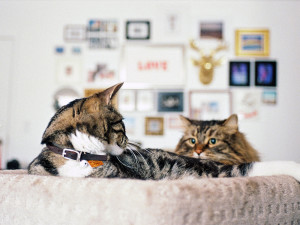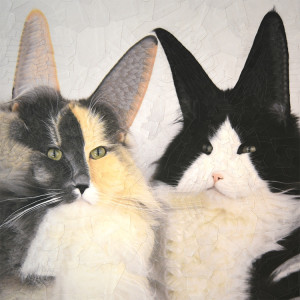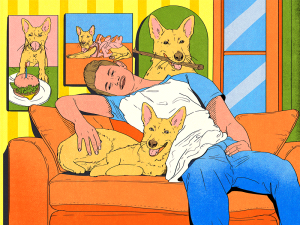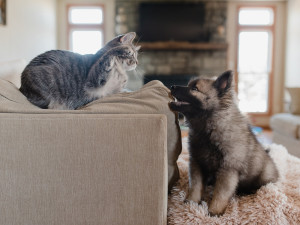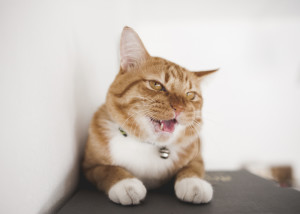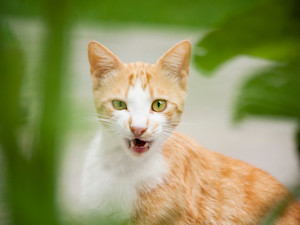Can Cats Understand Humans and Language?
Great, one more thing for them to judge us on: our conversation skills.

Share Article
In This Article:
Can Cats Understand Words? Do Cats Know Their Names? How to Communicate With Your Cat Frequently Asked Questions
It seems like a simple question: Does your cat know what you’re saying when you talk to them? It’s actually more complicated than you might think.
Research is lacking on cats in general. They started out as mysterious furballs and they continue to mystify. They’re also all unique. Each cat has their own ability for learning. How much we interact and try to teach them is a huge factor in what they learn. Of course, most of us think our cat is the smartest in the world and feel strongly that they understand a lot of what we say.
I’m actually in the midst of teaching my cat to use talking buttons. I admit my own theories on what cats understand have changed dramatically since I started this project. I wasn’t giving them enough credit. Their capacity for learning is astounding.
So, how do we really know what our cats understand? And what can we do to reinforce the words we want them to know?

Can cats understand words?
Cats rarely use just one sense, like hearing. They’re constantly engaging multiple senses to navigate their world. That goes for their interactions with us as well. It’s not just what you say but how you say it, how consistently you’ve said it the same way, and the word you’re saying that predicts will happen for your cat. These things help cats learn the relationship between certain words and their outcome.
Tone and body language
Your tone and body language can be just as important as the actual word when interacting with your cat. For example, let’s assume you regularly use a positive, light tone and relaxed or excited body language in the direction of your cat when you say “treat” and give your cat a treat. They’re reading the body language, tone, and verbal signals together and learning that they predict getting a treat.
If you were to say the same word, “treat,” in a sad tone while waving your arms above your head and facing away from your cat, they would be less likely to make the connection that a treat is coming their way. It’s not necessarily because your cat thinks you’re crazy and wants to avoid you. It’s because they didn’t recognize the usual combination of verbal and visual cues that, to them, mean “treat.”
Understanding vs. recognizing
This can be a tricky concept. It’s thought that cats are better at recognizing words than understanding words.
Recognizing something means that they’ve made a connection between two things using basic senses (sight, sound, touch, smell). Hearing the word “treat” (along with body language, tone, etc.) connects to a memory of getting a treat after hearing that word. With repetition, your cat learns that the word predicts a treat is coming. It’s thought this is how cats learn words.
Understanding something is more about knowing the meaning of that thing — what a treat is, how it’s delivered, perhaps what the ingredients are, and more. It’s thought that this level of understanding is beyond a cat’s natural cognitive abilities. Ongoing research will undoubtedly expand on these theories.
Do cats know their names?
Sure! They can learn their names the same way they learn any other word. Again, it’s not necessarily that they understand the concept or meaning of a name. But repetition, tone and body language paired with the word help a cat to recognize what comes next.
This is actually a great example to help you understand how tone and body language impact your cat’s reaction to the same word. You’ve probably used your cat’s name countless times to invite them for something positive like mealtime or a petting session. Even if you don't realize it, you’re using a positive tone and body language because you’re inviting your cat to a positive experience.
There are other times when you’ve probably paired a frustrated tone and body language with your cat’s name. Maybe they knocked something off a shelf. In those instances, your cat likely isn’t responding the same way they did in the example above. Even though the word is the same, other elements have changed. They pick up on those changes using their other senses. As a result, the meaning of the word essential changes from “Hey, come get something great!” to “Hey, what did you break?!”
That’s why it can be helpful to only use your cat�’s name in a positive context, so they’re more likely to respond reliably by coming when called.
How to communicate with your cat?
By now, you‘ve noticed a recurring theme. Repetition, consistency, tone, body language, and what happens next — those are the big things that help your cat learn words, visual cues, and even your moods.
Repetition of words and consistency
It’s important to pick the right word and repeat it the same way each time it’s used. Seem obvious? It’s harder than it sounds.
Let’s say you’re teaching your cat to sit on cue. The verbal cue is simple. “Sit.” But how you say it may change without you even noticing. “Sit, buddy.” “Sit, please.” “Can you sit down?” “Need you to sit.” And each of those variations comes with a change in tone. This makes it hard for your cat to recognize what you’re asking them to do.
Instead, keep it short and consistent. “Sit” in the same tone each time will make it much easier for your cat to connect your verbal cue with a behavior they (ideally) get rewarded for. That’s how they learn.
Body language
Some of the examples above show how important body language is. It’s not just noticeable when we’re mad at our cats. I have a friend who has the hardest time getting her cats in their carriers. Even though they don’t feel particularly comfortable around me, I can get them in the carriers pretty easily. Why? When I do it, I’m sitting calmly, petting them. It’s no big deal. Nothing to see here. Then, I gently scoop them up and set them in the carrier.
When my friend does it, she walks into the room like she’s getting ready to compete in a cat catching contest.
I’m exaggerating, but you get the idea. It’s like a linebacker, on alert, ready to bolt in any direction to try and land on top of a cat. She’s stressed from the get-go. They sense that body language immediately and know something’s up.
Body language matters in all communication and interaction with your cat. They are masters at it themselves. Odds are, they’re better at reading and interpreting human body language than we are.
Tone and emotion
It’s the same with tone and emotion. Cats pick up on shifts in our mental and emotional state. Those impact the way they interact with us, how safe they feel, whether they expect something positive or negative to happen. Of course, this will affect our ability to communicate with and teach them. Be aware of what you’re projecting through tone and emotion.
FAQs (People also ask):
How many human words do cats understand?
There’s no definitive answer on exactly how many words cats can understand. As we discuss above, it’s not the word itself that carries all of the impact anyway. A visual gesture or tone can say just as much to a cat. Each cat has their own unique capacity for learning.
Can cats learn human language?
Cats can learn to recognize human language, keeping in mind that, for cats, language means more than just saying a word. Body language and tone are also part of the way we communicate. Our cats can make connections between things we say and do and what happens next.
Do cats know their name?
Cats can learn to respond to their name. It‘s thought that they recognize words more than they understand them. So, your cat may not understand the concept of a name. But they know that they usually get something good when they hear the word and you sound happy. And when they hear the word and you sound upset, it’s not so positive for them.
References:

LeeAnna Buis, CFTBS, FFCP
LeeAnna Buis has adored cats her entire life and thought she knew them inside out and sideways. But it wasn’t until she worked with a feline behavior consultant that she fully understood how incredible, complicated, and inspiring they really are. She made a career change, starting the certification process to become a behavior consultant right away. She discovered what unique, fascinating, complex creatures cats are and knew this was what she wanted to do with her life — help others on a similar journey to truly knowing, loving, and appreciating their cats.
LeeAnna earned her certification through Animal Behavior Institute, where she received the certified feline training and behavior specialist (CFTBS) designation.
Related articles
![An artistic pink and green digitally altered portrait of Kaitlyn Aurelia Smith holding her cat]()
Kaitlyn Aurelia Smith’s Transcendent Music Is Inspired By the Language of Cats
Her serendipitous cat adoption story is just as otherworldly.
![illustration of a man cuddling a dog on a couch]()
What Does Your Love Language Say About You as a Pet Parent?
We all give and receive love in our own way, pets included.
![Woman With A Book And Her Cute Cat At Home.]()
In “Kitty Language,” Lili Chin Draws You a Literal Cheat Code to Your Cat
The author and artist uses informative (and freakin’ adorable) images to teach cat parents everything about kitty communication.
Cats vs. Dogs: Exploring Feline Intelligence and Canine IQ
A common (if not silly) question with a complicated answer.
![a cat making a strange face with its mouth open.]()
Is Your Cat Judging You?
That disapproving sneer is actually the “Flehmen response.” A cat behaviorist explains how to read cats’ lips.
![cat meowing]()
Why Does My Cat Meow So Much? Reasons Your Cat Meows Excessively
How to decode your cat’s love language when one meow has many meanings.
![A cat headbutting a woman on her laptop.]()
Why Does Your Cat Headbutt You? Curious Cat Behavior Explained
Apparently, you should take it as a compliment.
![A cat outside showing its bottom teeth.]()
What’s All the Cat Chatter About?
Scientists believe they could be mimicking the calls of their prey.


